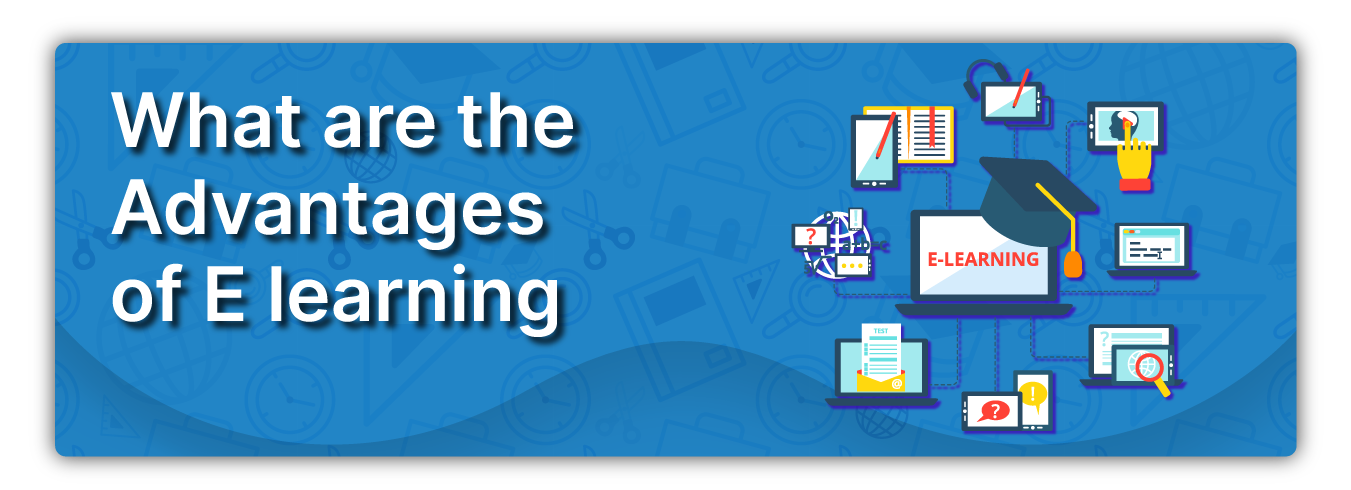E-Learning is an umbrella term for a variety of learning that takes place online. But, are you completely familiar with the concept of e-learning? Do you know what are the advantages of e-learning and how they benefit the learners? Learn about e-learning and the benefits of e-learning in detail through this blog.
What is E-Learning?
E-Learning refers to the type of online education that utilizes technology and the Internet to impart education. It allows access to learning that happens beyond the four walls of a classroom. Students get the freedom to learn the subjects they choose according to their time preferences. There is no need for a teacher to supervise learning. However, students can also attend real-time classes and clear their doubts without stepping out of their homes. Another feature of digital learning is its interactivity. The learning modules are in an audio-visual format and thus, work better at engaging the learners.
Additionally, the assessments in the online learning method are much more convenient for learners. They can take online quizzes and assessment tests to practice their concepts. For instance, Auro Scholar offers online quizzes where students can also get micro-scholarships while they practice. It offers a daily dose of learning with ‘Quiz of the Week’ and other such contests through its social media platforms like Facebook and Instagram.
E-learning offers several advantages for teachers as well as learners. Below is a list of the advantages of e-learning.
Advantages of E-Learning
1. Accommodative Method of Learning
Firstly, one of the biggest advantages of e-learning is that it suits the needs of every learner. The digital revolution brings everything to one place at the click of a button. Learners get an advantage to access content and learn from the comfort of their homes. Also, people from all walks of life get the freedom to learn with e-learning. They can choose a flexible schedule and work as they take different courses. Also, there are no age restrictions in an e-learning classroom. Learners can enroll, pursue and complete any course, no matter what age group they belong to. Thus, age does not limit learning and acquiring skills.
2. Saves Time and Money
Secondly, the cost-effective and time-saving nature of e-learning adds to the advantages of e-learning in the contemporary world. Students do not have to waste their time traveling for hours to reach the class. E-learning lessons are easily accessible through the Internet anytime and anywhere. Moreover, the material cost in e-learning is nil as all the study material is available in digital format. It does not require printing or publishing into paperbacks. Also, students can find the study material online in no time. It means they do not have to spend long hours looking for the right study material in a library. Thus, e-learning saves both time and money.
3. Provides Quick Lessons
Thirdly, quick lesson delivery is one of the advantages of e-learning. The e-learning modules are short and crisp, allowing students to learn quickly. Also, in a traditional learning classroom, the lesson delivery time is more in comparison to the student learning time. It takes up most of the class time and yields low results. However, online learning classes use audio-visual techniques to teach. So, the lessons become short and easy to understand. Another advantage of online learning is that it allows students to take and retake a class for better learning. They can learn at their own pace without having to stand the pressure of being left behind in the class.
4. Access to Updated Content
Updating the learning content is easy in an online learning environment. Teachers can quickly formulate lesson plans, create modules and update them in the online learning material database. Students have direct access to this database and can download the study material or view it there. It adds to the advantages of e-learning as the update process is easier and quicker than the traditional learning classroom. Students do not have to look for books in the library or go out to find them in the market. They can get everything in one place and learn without interruptions.
5. Consistent Learning
In a traditional classroom, the teachers hardly deviate from the teaching pattern they follow for teaching. Increases the chances of errors. Also, the teaching method may not be effective enough for all students. They may need a different method that suits their learning style. However, in a digital learning classroom, students can learn better with audio-visual techniques. It helps teachers remain consistent in lesson delivery, unlike the traditional classroom where they need to wait for every learner to understand. Furthermore, there is no particular requirement of a teacher every time. Students can learn without the help of a teacher too. Adding to the advantages of e-learning, several online courses offer a structured module format for learning that students can utilize for self-learning.
6. Better Retention & Recapitulation
The modern learners’ attention span is gradually reducing. Developments in technology and the easy accessibility of the Internet are the reasons behind it. People prefer watching a video or listening to a podcast rather than reading through the pages of a learning manual. Considering this, e-learning designers or instructional designers use different tools to make the learning content interactive. As a result, students engage with the learning material and remember most of the information. However, it is difficult in a traditional learning environment.
One of the crucial advantages of e-learning is that it allows learners to visit and revisit a module for revision. It helps them learn better and facilitates easy revision of concepts, ultimately enhancing students’ retention.
7. Offers Personalized Learning
Every learner is unique. Each learner follows a unique learning style. Adding another feather in the cap, the advantages of e-learning include personalized learning. Learners from diverse learning backgrounds and varied learning styles get a chance to learn together. Also, they can choose their subjects and navigate through the course at their convenience. Students can benefit through the advantages of online learning which offers them the freedom to choose what to learn and when to learn. Overall, digital learning gives learners a personalized learning experience by catering to their learning styles.
8. Analytics to Improve Learning
Another advantage of e-learning is that it provides real-time learning analytics to teachers. When using an online learning management system, teachers upload the content for the students and monitor their real-time progress. On the other hand, students learn through the study material and take assessment tests. The assessment scores reach the teachers through a dashboard and help them analyze the effectiveness of their teaching methods. Moreover, digital learning analytics also help students assess themselves and prepare for the next assessment accordingly. Eventually, the teaching methods become better and the learning outcomes improve.
Conclusion
E-learning, as a method of learning, is gradually becoming the go-to method of learning. The developments in technology and teaching methods make it an even better option to choose. The numerous advantages of e-learning clearly explain its effectiveness over the traditional learning methods. However, the benefits of e-learning are not confined to mere points. It is a dynamic learning method that works differently for every learner and educator.


